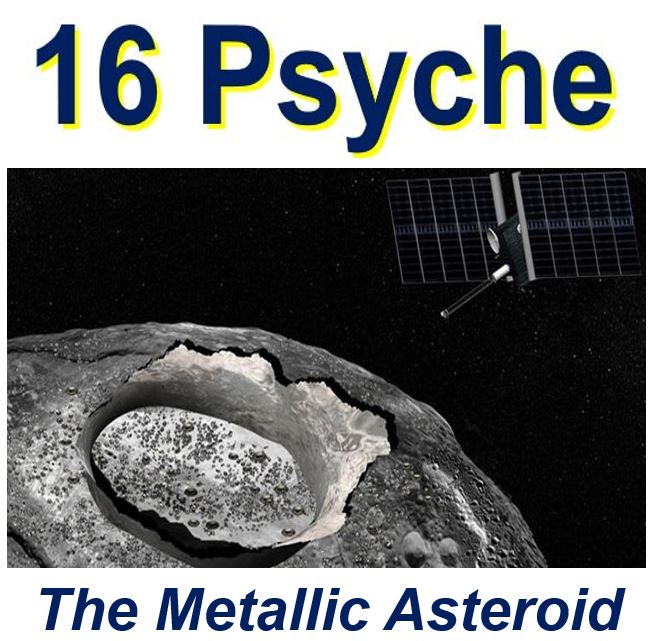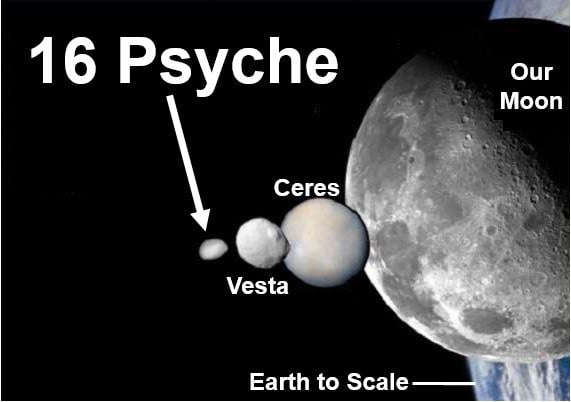A metallic asteroid known as 16 Psyche by scientists, will probably be studied by a NASA probe in the near future, the US space agency informed this week. The metallic asteroid might be the molten core of a Mars-sized planet, scientists believe.
Asteroid 16 Psyche orbits our Sun between Jupiter and Mars. It is probably made of remnants of a *protoplanet that was destroyed by a series of massive collisions that occurred during the formation of our Solar System.
* A protoplanet is a large body of matter that orbits the Sun (or any star), and is believed to be developing into a planet.
 An artist’s impression of 16 Psyche with the NASA probe nearby. (Image: lpl.arizona.edu)
An artist’s impression of 16 Psyche with the NASA probe nearby. (Image: lpl.arizona.edu)
Asteroid 16 Psyche is the biggest metallic asteroid we know of in the Solar System. NASA is considering sending a probe, which would be the first time a ‘metal world’ was studied by humans.
16 Psyche – clues to core formation
Studying the metallic asteroid might help us understand how Earth’s iron-nickel core was formed, as well as the cores of other planets.
In an interview with The Times, Linda Elkins-Tanton, Director of Arizona State University’s School of Earth and Space Exploration, said:
“If Psyche has a magnetic field then it was the molten core of a little planet that was stripped of its rocky exterior. Its original body might have been as small as *Vesta, or as large as Mars.”
* Vesta, a minor-planet, is the second biggest object in the asteroid belt, after dwarf planet Ceres. It has a mean diameter of 326 miles (525 km).
 16 Psyche is one of the largest asteroids in our Solar System. It could help us determine how the Earth’s core was formed. (Image: adapted from cdn.phys.org)
16 Psyche is one of the largest asteroids in our Solar System. It could help us determine how the Earth’s core was formed. (Image: adapted from cdn.phys.org)
16 Psyche has a diameter of approximately 150 miles (241 km) and is made almost completely of iron and nickel. With our current technology, it is probably the only planetary core that we will be able to examine directly .
If NASA approves the $500 million mission, the probe would be launched at the end of 2020, and would reach its destination in 2026.
Earlier this year, Prof. Elkins-Tanton said:
“Every world explored so far has a surface of ice, rock or gas. Now imagine a world made of iron and nickel. How alien it must be. But deep below Earth’s surface, unreachable to us, is a metal core resembling asteroid Psyche.”
“A mission to this metal world would be the equivalent to a mission deep below the surface of any of the terrestrial planets to examine their cores.”
Water discovered on 16 Psyche
Scientists from Arizona State University’s School of Earth and Space Exploration say they have discovered likely evidence for water on the surface of 16 Psyche.
Previous observations of the bolide showed no evidence of water on the surface. However, in a paper soon-to-be-published in The Astronomical Journal, Professor Vishnu Reddy argues that new observations from the NASA Infrared Telescope Facility show evidence for volatiles including hydroxyl or water on the asteroid’s surface.
Hydroxil is a free radical consisting of one hydrogen atom bound to an oxygen atom. It is known as the ‘detergent of the atmosphere’. In Earth’s atmosphere, it is extremely reactive and helps remove several chemical compounds.
Prof. Reddy, second author of the paper, said:
“”We did not expect a metallic asteroid like Psyche to be covered by water and/or hydroxyl. Metal-rich asteroids like Psyche are thought to have formed under dry conditions without the presence of water or hydroxyl, so we were puzzled by our observations at first.”
Asteroids are the remaining fragments from when the Solar System was being formed. Today, they orbit the Sun between Jupiter and Mars. They mainly fall into two categories:
– Those rich in carbon and volatiles.
– Those rich in silicates.
Psyche-like asteroids, i.e. metallic ones, are extremely rare. Scientists do not know where Psyche’s water came from.
Prof. Reddy said:
“We think the water we see on Psyche might have been delivered to its surface by carbonaceous asteroids that impacted Psyche in the distant past. Our discovery of carbon and water on an asteroid that isn’t supposed to have those compounds supports the notion that these building blocks of life could have been delivered to our Earth early in the history of our solar system history.”
The hydroxyl may be the product of solar wind interacting with Psyche’s silicate minerals, the scientists added.
Video – 16 Psyche
In this ASU School of Earth & Space Exploration video, Prof. Elkins-Tanton talks about her first proposal to NASA – sending a probe to 16 Psyche. In her KEDtalk, she discusses the proposed mission, and why we should continue exploring space.
